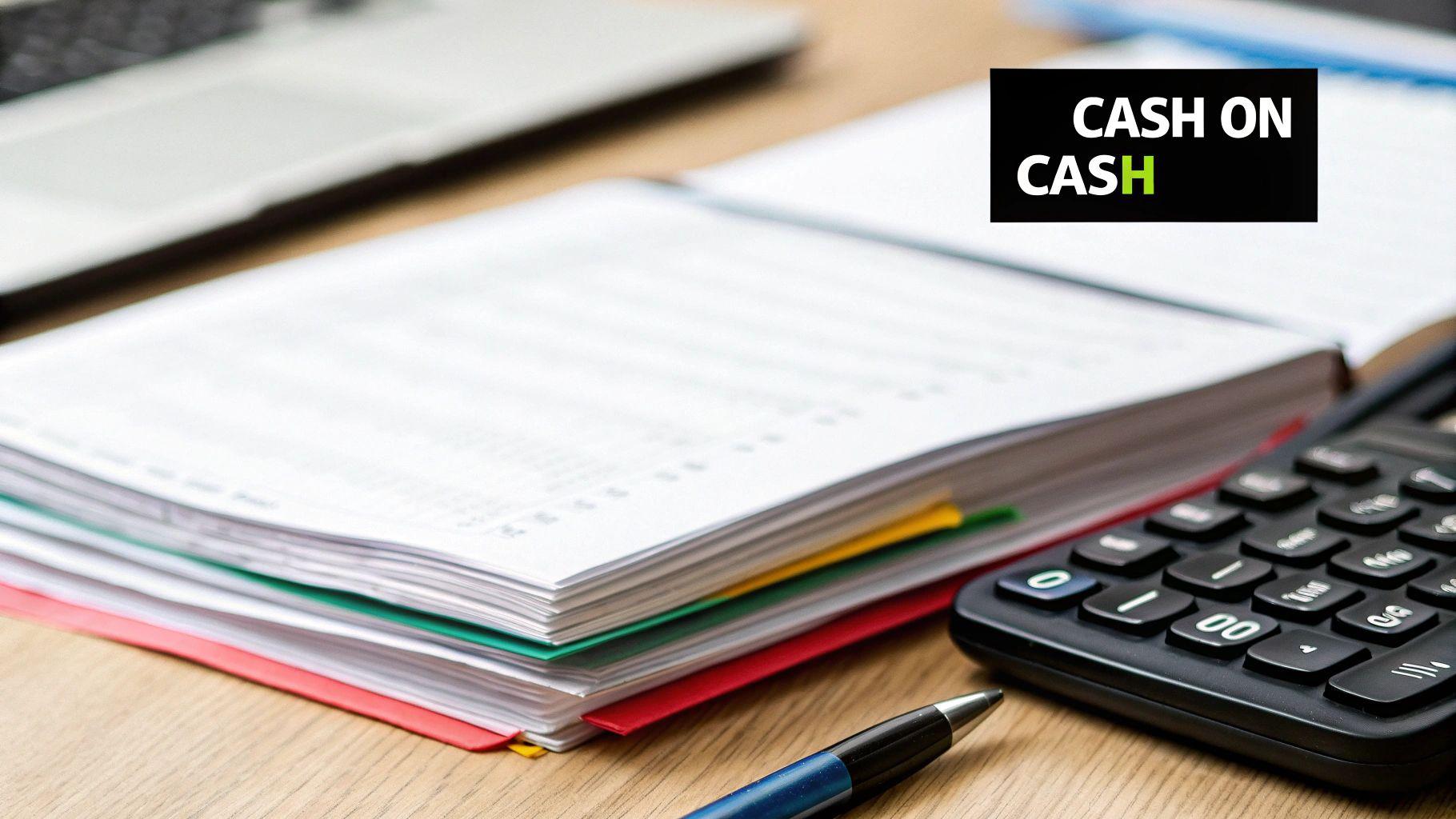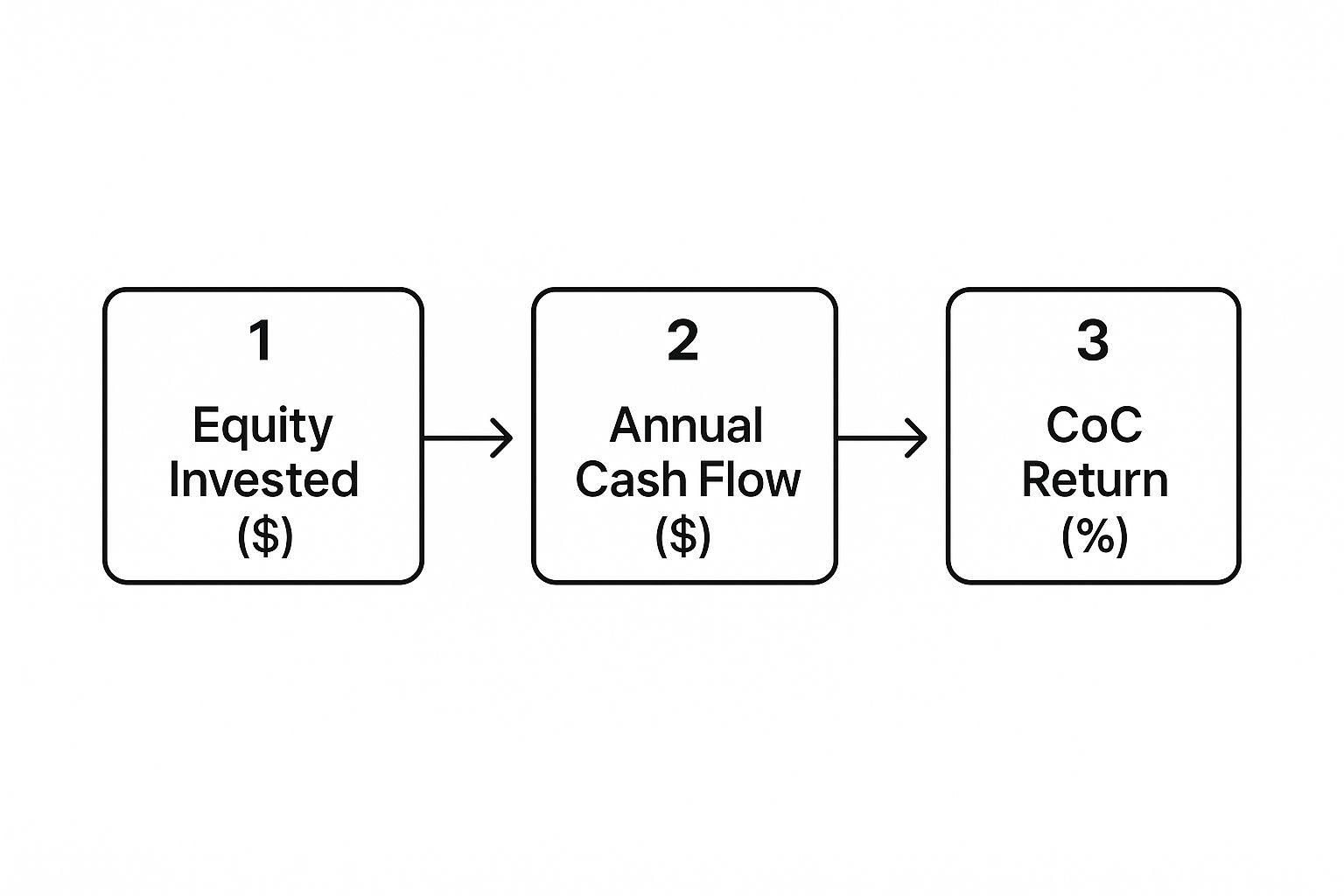Your Guide to Cash on Cash Return in Real Estate
Your Guide to Cash on Cash Return in Real Estate
Master cash on cash return with our clear guide. Learn to calculate it, see real-world examples, and understand why it's a key metric for real estate investors.
Domingo Valadez
Jul 14, 2025
Blog
When you're getting started in real estate investing, you'll hear a ton of different terms and metrics thrown around. But if you want to know how your actual, hard-earned cash is performing in a deal, the cash on cash return is the number you need to know.
Think of it this way: it’s the annual return you're getting, not on the property's total value, but on the real money you pulled out of your bank account to buy it. It's a straightforward way to see how effectively your deployed capital is working for you.
Why Cash On Cash Return Matters

In the world of real estate analysis, few metrics are as practical and instantly useful as the cash on cash return, often abbreviated as CoCR. While other calculations might factor in things like future appreciation or the total loan amount, CoCR hones in on a single, crucial question: "For every dollar I'm putting into this deal, how many cents am I getting back each year?"
This focus makes it an indispensable tool, especially when you're using financing to purchase a property. It allows you to cut through the noise and compare different investment opportunities on an apples-to-apples basis, based purely on the performance of your own cash.
The Core Components Of CoCR
At its heart, the calculation is refreshingly simple. It’s all about the relationship between the money that leaves your pocket and the money that flows back into it from the investment. To really get a grip on CoCR, you first need to understand these two key pieces of the puzzle.
Cash-on-Cash Return (CoCR) is a crucial metric in real estate investment, particularly for those leveraging or financing their investments. It measures the yearly return on the money invested into a property, helping investors evaluate their investment's performance. You can discover more insights about key underwriting metrics from Doorvest.
To calculate it, you just need two figures:
- Annual Pre-Tax Cash Flow: This is the net profit your property produces in a single year, before you account for income taxes. You find it by taking your total rental income and subtracting all operating expenses, which importantly includes your mortgage payment (both principal and interest).
- Total Cash Invested: This is the critical part. It’s not the purchase price of the property. It’s the total amount of your own money you had to bring to the table. This includes your down payment, all closing costs, and any money you spent on initial repairs or renovations to get the property rent-ready.
Let's look at these components a bit more closely.
Key Components of Cash on Cash Return
The table below breaks down the two main parts of the CoCR formula for a quick reference.
By focusing strictly on these two numbers, you get a clean, unclouded view of your investment's performance. It’s not distorted by the full property value or hypothetical appreciation—it’s just about your cash and what it's earning you right now.
Calculating Cash on Cash Return Step by Step
Alright, now that you know what cash on cash return is, let's roll up our sleeves and get into the numbers. The good news is the formula itself is pretty straightforward. It’s a powerful, back-of-the-napkin calculation you can use to quickly size up a deal's potential.
At its heart, the formula is:
Annual Pre-Tax Cash Flow ÷ Total Cash Invested = Cash on Cash Return
To get to that final percentage, we first need to figure out those two key pieces: your annual cash flow and the total cash you actually put into the deal. Let's walk through how to pin down each of those numbers.
Finding Your Annual Pre-Tax Cash Flow
Your annual pre-tax cash flow is simply the profit your property spits out over a year, before you've paid any income taxes. Think of it as the money left in your pocket after all the property’s bills are paid—including the mortgage.
Here’s how you get there:
- Gross Scheduled Income: First, figure out the absolute maximum rent you could collect if the property was 100% occupied all year.
- Vacancy Costs: Let's be real—no property is full all the time. You need to account for this. A good rule of thumb is to subtract 5-10% of your gross income for potential vacancies.
- Operating Expenses: This is where you have to be brutally honest with yourself. Subtract every single cost associated with running the property. This includes:Property TaxesHomeowners InsuranceRepairs and MaintenanceProperty Management FeesUtilities (if you're paying any)HOA Dues
Once you subtract vacancy and operating expenses from your gross income, you have what's called your Net Operating Income (NOI). But we're not done yet. To find your final cash flow, you have to subtract one more major expense: your annual mortgage payments (both principal and interest).
Your annual pre-tax cash flow is the real-world profit from the property. It’s the cash that’s actually left over after every single bill is settled.
Determining Your Total Cash Invested
Next up is the "Total Cash Invested" part of the equation. This isn't the purchase price of the property. It’s the total amount of cold, hard cash you had to bring to the table to make the deal happen.
Your Total Cash Invested is the sum of:
- The Down Payment: This is usually the biggest piece of the puzzle.
- Closing Costs: All those pesky fees for loan origination, appraisals, title insurance, and so on.
- Initial Renovation Costs: Any money you spent upfront on repairs or improvements just to get the property rent-ready.
Add those up, and you’ve got the bottom number for our formula. This visual guide really helps put it all together.

This simple flow chart shows how the cash you put in generates the annual cash flow, which gives you your return. For an even more detailed look, you can check out our complete guide on the cash on cash calculation.
A final pro tip: When you're adding up your operating expenses, be thorough. A detailed property management guide can be a lifesaver here, helping you remember costs you might have forgotten. The more accurate your expenses, the more reliable your cash on cash return figure will be.
Putting the Formula into Practice with Real Examples

Theory is great, but let's be honest—it’s seeing the numbers in action that really makes a concept like cash on cash return click. To bring it to life, we're going to walk through two distinct real estate investment scenarios, side by side.
We'll compare a classic single-family rental against a small multi-family property. By breaking down the numbers for each—from the purchase price and operating costs all the way to the final return—you'll see exactly how financing and property type can dramatically shape your results.
Example 1: The Single-Family Rental
Let's say you’ve found a great-looking single-family home on the market for $300,000. You line up your financing and get ready to rent it out. This is a very common starting point for many people getting into real estate.
First, let's figure out how much cash you actually need to bring to the table.
- Purchase Price: $300,000
- Down Payment (20%): $60,000
- Closing Costs (3%): $9,000
- Initial Repairs: $6,000
- Total Cash Invested:$75,000
Now, for the income side. The property rents for $2,500 per month, which brings in $30,000 in gross rental income for the year.
Of course, we have to subtract the expenses to find our actual cash flow:
- Property Taxes: $4,500/year
- Insurance: $1,500/year
- Maintenance & Vacancy (10% of gross rent): $3,000/year
- Annual Mortgage Payments: $16,800/year
After subtracting these costs ($25,800) from the gross income ($30,000), you're left with an annual pre-tax cash flow of $4,200.
Time for the final calculation:
($4,200 Annual Cash Flow / $75,000 Total Cash Invested) = 5.6% Cash on Cash Return
A 5.6% return is a respectable result. Don't forget, on top of this cash flow, you are also building equity as you pay down the mortgage and the property itself is likely appreciating in value.
Example 2: The Small Multi-Family Property
Next up, let's analyze a small duplex listed for $450,000. Because it’s a multi-family property, the lender might require a slightly larger down payment, but the math for cash on cash return works exactly the same way.
Here’s the breakdown of your initial cash investment:
- Purchase Price: $450,000
- Down Payment (25%): $112,500
- Closing Costs (3%): $13,500
- Initial Repairs: $14,000
- Total Cash Invested:$140,000
Each of the two units rents for $1,800 a month. That gives you a total of $3,600 in monthly rent, or a gross annual income of $43,200.
Now for the annual expenses on the duplex:
- Property Taxes: $6,000/year
- Insurance: $2,400/year
- Maintenance & Vacancy (10%): $4,320/year
- Annual Mortgage Payments: $21,600/year
Subtracting the total expenses ($34,320) from the gross income ($43,200) leaves you with an annual pre-tax cash flow of $8,880.
Let's plug these numbers into the formula:
($8,880 Annual Cash Flow / $140,000 Total Cash Invested) = 6.34% Cash on Cash Return
Even with a significantly larger cash investment upfront, the duplex delivers a stronger immediate cash return. This comparison perfectly illustrates why running the numbers is absolutely critical before you ever commit to a deal.
While this metric is a cornerstone of real estate, the core principle of measuring the return on your initial cash is just as vital in other businesses, like figuring out profitability in ventures covered in guides for online arbitrage for beginners.
What Is a Good Cash on Cash Return?
So, you’ve run the numbers and now you're staring at the result, asking the one question every investor asks: "Is this a good deal?"
When it comes to cash on cash return, there isn’t a single magic number that signals a home run. The truth is, what counts as a “good” return is entirely personal. It really comes down to your own investment goals, how much risk you're comfortable with, and the specific market you’re looking at.
A common benchmark you’ll hear tossed around is a return somewhere between 8% and 12%. For a lot of investors, hitting this range means the property is kicking off solid, healthy cash flow compared to the money they’ve put in. But think of this as a general rule of thumb, not a law set in stone.
Context Is Everything
A property’s cash on cash return doesn't tell the whole story on its own. A smart investor always asks, "What else could I be doing with this money?" Comparing potential deals is where this metric really shines.
For instance, let's say you find a property with an 8% cash on cash return. That might sound just okay at first. But if other, less hands-on investments like bonds are only yielding similar or even lower returns—without the added bonus of property appreciation—that 8% starts to look pretty fantastic. You can get a feel for how different investments stack up by checking out historical returns data from Quantified Strategies.
This kind of comparison gives you crucial context. It forces you to weigh whether the effort and risk of owning real estate are truly worth the reward compared to more passive options.
Your Strategy Defines Your Target
Ultimately, your personal investment strategy is the compass that guides what a "good" cash on cash return looks like for you. Most investors fall into one of two main camps, and each has very different expectations.
Cash Flow Focused Investors:
* These folks are all about immediate, predictable income. They want their properties to be money-making machines from day one.
* They’re typically hunting for higher returns, often aiming for 10% or more.
* You’ll see this strategy a lot in stable, more affordable markets where you can achieve high rents relative to property prices.
Appreciation Focused Investors:
* This group is playing the long game. They’re perfectly willing to accept a lower initial cash on cash return.
* A return of 4-6% might be perfectly acceptable if the property is in a hot, high-growth area where they expect its value to soar over time.
* Their main goal isn’t monthly income; it’s building serious wealth as the property’s value climbs.
So, you have to decide what matters most. Are you investing for a monthly check to supplement your income, or are you banking on appreciation to build your net worth over the next decade?
A lower CoCR in a booming market with huge appreciation potential can be a fantastic investment, while a higher CoCR in a flat, going-nowhere market might be a trap. Figure out your "why" first—then you'll know what a "good" return looks like for you.
Understanding The Limits Of Cash On Cash Return

when evaluating long-term profitability.
A great investment is rarely defined by a single metric. Cash on cash return is your starting point, not your finish line. It tells you about the cash flow today, but not about the total wealth you're building for tomorrow.
To really get a handle on this, let's lay out the good and the bad side-by-side.
Evaluating Cash on Cash Return: A Balanced View
This table sums up where CoCR shines and where its blind spots are. Use it to remember how to fit this metric into a bigger, smarter analysis.
At the end of the day, a healthy cash on cash return is a great sign. It's often the first thing I look at. But it should always be the start of your due diligence, never the end. To see the deal's true, full potential, you have to pair CoCR with other powerful metrics like the overall Return on Investment (ROI) and the Internal Rate of Return (IRR), which factor in those long-term wealth builders.
Answering Your Top Questions About CoCR
As you start putting the cash on cash return metric to work analyzing deals, you're bound to run into a few questions. It happens to everyone. Let's walk through some of the most common ones so you can use this tool with complete confidence.
How Is Cash on Cash Return Different From ROI?
This is probably the biggest point of confusion for new investors, and getting it right is crucial. The simplest way to think about it is that CoCR measures how hard your cash is working, while Return on Investment (ROI) measures the performance of the entire asset.
- Cash on Cash Return zooms in on the annual cash flow you receive compared to the actual out-of-pocket cash you put into the deal. It doesn't care about property appreciation or the equity you build from paying down your mortgage. It’s all about the immediate, tangible cash hitting your bank account from your initial investment.
- Return on Investment (ROI) takes a much wider, long-term view. It calculates the total profit over the entire life of the investment—factoring in everything from rental income and appreciation to the final sale proceeds—and compares it to the total cost of the investment.
Think of it this way: CoCR gives you a yearly snapshot of your cash performance, whereas ROI tells the full story of your investment’s profitability from beginning to end.
Does Cash on Cash Return Change Over Time?
Absolutely. The number you calculate before buying a property is just a first-year projection. Any experienced investor knows that cash on cash return is a living, breathing metric that will change over the life of the investment.
For instance, if you successfully raise rents by $100 a month, you've just added $1,200 to your annual cash flow. That directly boosts your CoCR without you having to invest another penny. On the flip side, a major unexpected expense like a new HVAC unit can tank your return for that year. The metric can also get a serious lift if you refinance into a lower interest rate, which drops your annual debt service and leaves more cash in your pocket. This kind of fluctuation is completely normal.
How Is CoCR Used in Real Estate Syndications?
In a real estate syndication—where a group of investors pools their capital to buy a large property—cash on cash return is a foundational metric. For a passive investor, it answers the single most important question: "If I invest $50,000 in this deal, how much cash can I expect to get back each year?"
For both the syndicator running the deal and the investors backing it, the projected cash on cash return is a key indicator of the property's ability to generate income. It helps set clear expectations for preferred returns and regular cash distributions, making it an essential piece of any investment summary.
Of course, the broader economic environment always plays a part. Historical data reminds us that returns aren't guaranteed. Between 1932 and 1955, for example, cash returned only about 0.7% annually. More recently, from 2008 to 2020, the average was just 0.6%. You can dive deeper into how market conditions affect asset returns at A Wealth of Common Sense. This is why it’s so critical for investors to look at CoCR projections within the context of the current economy.
Managing investor expectations and reporting these metrics clearly is what separates the most successful syndicators from everyone else. Homebase provides an all-in-one platform to manage everything from fundraising to distributions, freeing you up to find great deals instead of wrestling with spreadsheets. See how you can streamline your operations with Homebase.
Share On Linkedin
Share On Twitter
Share On Linkedin
Share On Twitter
DOMINGO VALADEZ is the co-founder at Homebase and a former product strategy manager at Google.
What To Read Next
Raise Capital for Real Estate A Sponsor Playbook
Blog
Learn how to raise capital for real estate with this sponsor playbook. Get actionable steps on deal structuring, investor outreach, and closing.
Sign up for the newsletter
If you want relevant updates from our team at Homebase, sign up! Your email is never shared.
Sign up for the newsletter
If you want relevant updates from our team at Homebase, sign up! Your email is never shared.
© 2025 Homebase. All rights reserved.